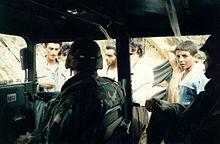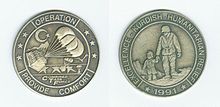- Operation Provide Comfort
-
Operation Provide Comfort/Provide Comfort II Part of Iraqi no-fly zones Date March 1991 – 31 December 1996 Location Northern Iraq Result Establishment of Kurdish de facto autonomous region in northern Iraq Belligerents  United States
United States
 United Kingdom
United Kingdom
 France
France
 Australia
Australia
 Netherlands
Netherlands
 Turkey
Turkey Iraq
IraqCommanders and leaders  John Shalikashvili
John Shalikashvili Saddam Hussein
Saddam HusseinCasualties and losses 2 UH-60 Blackhawk helicopters shot down (friendly fire, 26 killed) Unknown
Many air defense systems destroyed
1 MiG-23 Flogger shot down
2 Su-22 Fitters shot down[1]Recent wars and conflicts
in the Persian GulfIran-Iraq War – Opera – Gulf War – 1991 uprisings – Provide Comfort – Southern Watch – 1993 cruise missile strikes – Iraqi Kurdish Civil War – Desert Strike – Northern Watch – Desert Fox – Kurdistan Islamist Conflict – Southern Focus – Iraq War – 2011 Bahraini protests
 Then-Lt. Col. John Abizaid speaking with some Kurds in Northern Iraq during Operation Provide Comfort, 1991
Then-Lt. Col. John Abizaid speaking with some Kurds in Northern Iraq during Operation Provide Comfort, 1991
Operation Provide Comfort and Provide Comfort II were military operations by the United States and some of its Gulf War allies, starting in April 1991, to defend Kurds fleeing their homes in northern Iraq in the aftermath of the Persian Gulf War and deliver humanitarian aid to them.
Contents
Operation Provide Comfort
The 1991 uprising in northern Iraq resulted in an Iraqi military response towards the rebels in both northern and southern Iraq. Fearing a massacre like what had happened during the 1988 Anfal campaign, millions of Kurds fled towards the Turkish border.
On 3 March, General Norman Schwarzkopf warned the Iraqis that Coalition aircraft would shoot down Iraqi military aircraft flying over the country. On 20 March, an American F-15C Eagle fighter shot down an Iraqi Air Force Su-22 Fitter fighter-bomber over northern Iraq. On 22 March, another F-15 destroyed a second Su-22 and the pilot of an Iraqi PC-9 trainer bailed out after being approached by American fighters.[1]
On 5 April, the UN passed United Nations Resolution 688, calling on Iraq to end repression of its population. On 6 April, Operation Provide Comfort began to bring humanitarian relief to the Kurds. A No-Fly Zone was established by the U.S., the UK and France north of the 36th parallel. This was enforced by American, British and French aircraft. Included in this effort was the delivery of humanitarian relief and military protection of the Kurds by a small Allied (US/UK/Fr/Tu) ground force based in Turkey. Also participating was the 3/325 Airborne Battalion Combat Team, based in Vicenza, Italy, and commanded by then-Lt. Col. John Abizaid. With the 3/325, was a Task Force of 6 Blackhwaks and highly trained Special crews lead by Cpt Morris and SSG Bluman from Geibelstadt Germany. Fifteen UH-60 Blackhawks and 5 OH-58D helicopters crews and support personnel from the 11th ACR in Fulda, Germany self deployed to join the operation in mid April. The 11th ACR contingent remained there until mid October. Among other individual utility missions, the 11th ACR contingent provided the majority of the support for the State Department mission run by Lt. Colonel Richard Naab, the shuttle flights back to Incirlik, and the air support for the ready reaction forces provided by the USMC. (references www.ifrad.us/11acrhistory.html and www.history.army.mil/html/books/humanitarian_intervention/index.html).
Units of the 18th Military Police Brigade,commanded by Col Lucious Delk, with units of the 709th MP Battalion, the 284th MP Co and the 564th MP Co, provided security of headquarters, Kurdish refugee camps and convoy security. The Brigade was the last unit to leave the area at conclusion of operations.
While Operations Desert Shield and Desert Storm were run by the US Central Command (CENTCOM), Operation Provide Comfort came under the authority of the US European Command (EUCOM), headquartered in Vaihingen, Germany. On-ground humanitarian aid was provided by the 353rd Civil Affairs Command, Bronx, New York, and by subordinate units 432nd Civil Affairs Battalion, Green Bay, Wisconsin and 431st Civil Affairs BN, Little Rock, Arkansas. These units were relocated to Turkey and Northern Iraq after completing missions in Kuwait. They were soon joined by Lieutenant Colonel Ted Sahlin's 96th Civil Affairs Battalion (Airborne) from Fort Bragg, North Carolina, which had only returned to the U.S. two weeks before after having been deployed to Saudi Arabia, Iraq and Kuwait for the past 10 months. The base camps that were established for Kurdish refugees were nicknamed Camp Jayhawk and Camp Badger after college mascots. Other camps were established in Silopi, Turkey for multi-national troops sent to assist with the operation. One such camp was built in Silopi, Turkey by members of the 36th Civil Engineering Squadron from Bitburg Air Base, Germany. Smaller "detachment" camps were also built in and around Zhako, Iraq by these same members and were led by Captain Donald Gleason and Master Sergeant Timothy Burke, both of the U.S. Air Force. They led a team of fifty civil engineers that is now known as the first Air Force civil engineering unit to enter Iraq. Also deployed to Zhako from their main-body deployment site in Rota, Spain, was Naval Mobile Construction Battalion 133, homeported in Gulfport. It provided humanitarian aid, water wells, and minor repairs to Sirsink air field (Prime BEEF team members from Bitburg provided the major airfield repairs)from bomb damage received during Operation Desert Storm. Like its Air Force counterparts, it was the first Naval Mobile Construction Battalion to enter Iraq prior to Operation Iraqi Freedom. USS FORRESTAL (CV-59) and her Carrier Task Force commanded by Commander, Carrier Group Six commenced her 21st and final operational deployment on 30 May 1991. During this period she provided air power presence and airborne intelligence support (the airwing flew over 900 sorties over Iraq) to the Combined Joint Task Forces of Operation Provide Comfort and Operation Northern Watch enforcing the northern "no-fly zone" in Iraq. During this last deployment FORRESTAL served in a number of new and innovative battle group and carrier roles. She completed this deployment on 23 December 1991.
Lieutenant General John Shalikashvili commanded the overall operation and later became Chairman of the Joint Chiefs of Staff.
At the tip of the spear was the United States Marine Corps' 24th Marine Expeditionary Unit led by Colonel James L. Jones, who later became Commandant of the Marine Corps; Supreme Allied Commander, Europe(SACEUR); and National Security Advisor for President Barack Obama. The Marine Expeditionary Unit was under the command of Commodore Turner, commander, Mediterranean Amphibious Ready Group 1–91, aboard his flagship, the USS Guadalcanal.
Some US allies contributed to the operation, including the United Kingdom, France, the Netherlands and Australia. Britain deployed 40 and 45 Commando Royal Marines and air transport assets to help protect refugees and to deliver humanitarian aid. The British used the name Operation Haven.[2][3] France deployed transport aircraft and special forces, the Netherlands deployed troops from the Netherlands Marine Corps and an Army Medical/Engineering Battalion, and Australia contributed transport aircraft and medical, dental and preventive health teams (under the Australian name, Operation Habitat.[4]
Operation Provide Comfort ended on 24 July 1991.
Operation Provide Comfort II
Operation Provide Comfort II began on 24 July 1991, the same day Provide Comfort ended. This operation was primarily military in nature, and its mission was to prevent Iraqi aggression against the Kurds.
Partly as a result of Western commitment to the Kurds, Iraqi troops were withdrawn from the Kurdish regions in October 1991 and these areas assumed de facto independence.
On 5 April 1992, the Iranian Air Force bombed bases in northern Iraq belonging to the Kurdistan Democratic Party of Iran. Iraqi jets were scrambled to intercept the intruders while Coalition aircraft did not interfere.[1]
On 15 January 1993, Iraqi air defense sites opened fire on two USAF F-111 bombers. On 17 January, Iraqi air defense systems fired on two F-16 jets, and a US F-4 Phantom destroyed an Iraqi radar which had been targeting French reconnaissance aircraft. Around a half hour later, an American F-16 shot down an Iraqi MiG-23 Flogger which had crossed into the no-fly zone.[5][6] The next day, American F-16s bombed Bashiqah Airfield and F-4 Phantoms attacked Iraqi air defense sites. Over the next few days and months, more Iraqi sites fired on the American patrols, and several were attacked. That August, the USAF deployed the F-15E Strike Eagle aircraft to Turkey, and on 18 August, these aircraft dropped four laser-guided bombs on an Iraqi SA-3 site near Mosul.[1]
On 14 April 1994, two United States Air Force F-15 Eagle fighters on a Provide Comfort patrol mistakenly downed two United States Army Black Hawk helicopters carrying twenty-six Allied personnel, killing all aboard.
For more details on this topic, see 1994 Black Hawk shootdown incident.On 9 December 1995, F-4G Phantom aircraft of the Idaho Air National Guard finished their tour of duty with Combined Task Force Provide Comfort at Incirlik Air Base. This was the last operational use of the F-4 Phantom by the USAF.[1]
In August 1996, Iraqi troops intervened in the Kurdish regions of Iraq, and the United States responded with Operation Desert Strike against targets in southern Iraq. As a result, some incidents occurred in northern Iraq, and the United States launched an operation to evacuate certain pro-American Kurds from northern Iraq.
The operation ended officially on 31 December 1996 at the request of the Government of Turkey who wanted to improve relations with Iran and Iraq. It was followed by Operation Northern Watch, which began on 1 January 1997 with the mission of enforcing the northern no-fly zone. France declined to participate in Operation Northern Watch.
References
- ^ a b c d e "Operation Provide Comfort II". Global Security.org. http://www.globalsecurity.org/military/ops/provide_comfort_2.htm. Retrieved 10 October 2008.
- ^ "1991: UK forces withdraw from Kurdish haven". BBC News. 14 July 1991. http://news.bbc.co.uk/onthisday/hi/dates/stories/july/14/newsid_2503000/2503447.stm. Retrieved 10 October 2008.
- ^ "Royal Marines – Operations , History". Eliteukforces.info. http://www.eliteukforces.info/royal-marines/operations/. Retrieved 10 October 2008.
- ^ "Royal Australian Air Force (RAAF)". Defence.gov.au. Archived from the original on 1 May 2008. http://web.archive.org/web/20080501125418/http://www.defence.gov.au/raaf/history/airforce_history/gulfwar.htm. Retrieved 10 October 2008.
- ^ F-16 Airframe Details for 86-0262
- ^ http://www.fighterpilotuniversity.com/index.cfm/2008/1/17/Cleared-to-Lead-and-Kill-MiGs
Further reading
- Rudd, Gordon W. (2004). Humanitarian Intervention: Assisting the Iraqi Kurds in Operation Provide Comfort, 1991. Washington, D.C.: United States Army Center of Military History. http://www.history.army.mil/html/books/humanitarian_intervention/index.html.
Gulf War Invasion of Kuwait Battle of Dasman Palace · The Battle of the Bridges · Battle of Failaka · UN Resolution 660
Coalition Invasion UN Resolution 661 · Coalition · Iraq-United States relations · Carter Doctrine · Military equipment
Battles Air Campaign · "Package Q" Air Strike · Khafji · Wadi Al-Batin · 67 Easting · 73 Easting · Al Busayyah · Phase Line Bullet · Medina Ridge · 2nd Kuwait · Highway of Death · Jalibah · Norfolk · Rumaila · Safwan
Aftermath Operation Southern Watch · Iraq sanctions · Kuwaiti oil fires · 1991 uprisings in Iraq · Draining of the Mesopotamian Marshes · Gulf War oil spill · Depleted uranium · Gulf War syndrome · Awards · Operation Provide Comfort
Outline Timeline of the conflict · Disarmament timeline
Categories:- 1991 in Iraq
- 1992 in Iraq
- 1993 in Iraq
- 1994 in Iraq
- 1995 in Iraq
- 1996 in Iraq
- Conflicts in 1991
- Conflicts in 1993
- Conflicts in 1996
- Friendly fire incidents
- Humanitarian military operations
- Military history of the United States (1900–1999)
- Military operations involving France
- Military operations involving the United Kingdom
- Military operations involving the United States
- Military operations of the Gulf War
- Non-combat military operations involving Australia
- United States Marine Corps in the 20th century
- Iraq–United States relations
- Iraq–United Kingdom relations
Wikimedia Foundation. 2010.

